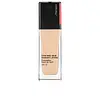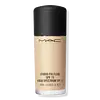Shiseido Synchro Skin Radiant Lifting Foundation SPF 30 Versus Mac Cosmetics Studio Fix Fluid Foundation With SPF 15
What's inside
What's inside
 Key Ingredients
Key Ingredients

 Benefits
Benefits

 Concerns
Concerns

 Ingredients Side-by-side
Ingredients Side-by-side

Ethylhexyl Methoxycinnamate 6.9%
UV AbsorberTitanium Dioxide 1%
Cosmetic ColorantWater
Skin ConditioningDimethicone
EmollientDiphenylsiloxy Phenyl Trimethicone
Skin ConditioningGlycerin
HumectantTrifluoropropyldimethyl/Trimethylsiloxysilicate
EmollientButylene Glycol
HumectantHydrogenated Polydecene
EmollientPEG-10 Dimethicone
Skin ConditioningBis-Butyldimethicone Polyglyceryl-3
CleansingDisteardimonium Hectorite
StabilisingErythritol
HumectantXylitol
HumectantSorbitan Sesquiisostearate
EmulsifyingPolyquaternium-51
Skin ConditioningCitrus Unshiu Peel Extract
MaskingThymus Serpyllum Extract
Skin ConditioningFagus Sylvatica Bud Extract
TonicHydrolyzed Conchiolin Protein
Skin ConditioningDimethicone/Vinyl Dimethicone Crosspolymer
Skin ConditioningDimethicone/PEG-10/15 Crosspolymer
CI 77120
Cosmetic ColorantSynthetic Fluorphlogopite
Aluminum Hydroxide
EmollientPolysilicone-2
Disodium EDTA
Stearic Acid
CleansingCalcium Aluminum Borosilicate
Tocopherol
AntioxidantDipropylene Glycol
HumectantTriethoxycaprylylsilane
Triethoxysilylethyl Polydimethylsiloxyethyl Dimethicone
Skin ConditioningBHT
AntioxidantAlumina
AbrasivePolymethylsilsesquioxane
Phenoxyethanol
PreservativeIron Oxides
Mica
Cosmetic ColorantEthylhexyl Methoxycinnamate 6.9%, Titanium Dioxide 1%, Water, Dimethicone, Diphenylsiloxy Phenyl Trimethicone, Glycerin, Trifluoropropyldimethyl/Trimethylsiloxysilicate, Butylene Glycol, Hydrogenated Polydecene, PEG-10 Dimethicone, Bis-Butyldimethicone Polyglyceryl-3, Disteardimonium Hectorite, Erythritol, Xylitol, Sorbitan Sesquiisostearate, Polyquaternium-51, Citrus Unshiu Peel Extract, Thymus Serpyllum Extract, Fagus Sylvatica Bud Extract, Hydrolyzed Conchiolin Protein, Dimethicone/Vinyl Dimethicone Crosspolymer, Dimethicone/PEG-10/15 Crosspolymer, CI 77120, Synthetic Fluorphlogopite, Aluminum Hydroxide, Polysilicone-2, Disodium EDTA, Stearic Acid, Calcium Aluminum Borosilicate, Tocopherol, Dipropylene Glycol, Triethoxycaprylylsilane, Triethoxysilylethyl Polydimethylsiloxyethyl Dimethicone, BHT, Alumina, Polymethylsilsesquioxane, Phenoxyethanol, Iron Oxides, Mica
Ethylhexyl Methoxycinnamate 2.5%
UV AbsorberTitanium Dioxide 1%
Cosmetic ColorantWater
Skin ConditioningCyclopentasiloxane
EmollientPEG-10 Dimethicone
Skin ConditioningButylene Glycol
HumectantTrimethylsiloxysilicate
EmollientDimethicone
EmollientMagnesium Sulfate
Laminaria Saccharina Extract
Skin ProtectingAlgae Extract
EmollientTocopheryl Acetate
AntioxidantSodium Hyaluronate
HumectantTocopherol
AntioxidantLecithin
EmollientHydrogenated Lecithin
EmulsifyingXanthan Gum
EmulsifyingSorbitan Sesquioleate
EmulsifyingMethoxy Amodimethicone/Silsesquioxane Copolymer
Skin ConditioningLaureth-7
EmulsifyingDipropylene Glycol
HumectantDimethicone/PEG-10/15 Crosspolymer
Dimethicone/PEG-10 Crosspolymer
EmollientPEG/PPG-18/18 Dimethicone
EmulsifyingDisteardimonium Hectorite
StabilisingSilica
AbrasiveDimethicone Crosspolymer
Emulsion StabilisingTriethoxycaprylylsilane
Propylene Carbonate
SolventPentaerythrityl Tetra-Di-T-Butyl Hydroxyhydrocinnamate
AntioxidantSorbic Acid
PreservativeChloroxylenol
AntimicrobialPhenoxyethanol
PreservativeCI 77891
Cosmetic ColorantIron Oxides
CI 77288
Cosmetic ColorantEthylhexyl Methoxycinnamate 2.5%, Titanium Dioxide 1%, Water, Cyclopentasiloxane, PEG-10 Dimethicone, Butylene Glycol, Trimethylsiloxysilicate, Dimethicone, Magnesium Sulfate, Laminaria Saccharina Extract, Algae Extract, Tocopheryl Acetate, Sodium Hyaluronate, Tocopherol, Lecithin, Hydrogenated Lecithin, Xanthan Gum, Sorbitan Sesquioleate, Methoxy Amodimethicone/Silsesquioxane Copolymer, Laureth-7, Dipropylene Glycol, Dimethicone/PEG-10/15 Crosspolymer, Dimethicone/PEG-10 Crosspolymer, PEG/PPG-18/18 Dimethicone, Disteardimonium Hectorite, Silica, Dimethicone Crosspolymer, Triethoxycaprylylsilane, Propylene Carbonate, Pentaerythrityl Tetra-Di-T-Butyl Hydroxyhydrocinnamate, Sorbic Acid, Chloroxylenol, Phenoxyethanol, CI 77891, Iron Oxides, CI 77288
 Reviews
Reviews

Ingredients Explained
These ingredients are found in both products.
Ingredients higher up in an ingredient list are typically present in a larger amount.
Butylene Glycol (or BG) is used within cosmetic products for a few different reasons:
Overall, Butylene Glycol is a safe and well-rounded ingredient that works well with other ingredients.
Though this ingredient works well with most skin types, some people with sensitive skin may experience a reaction such as allergic rashes, closed comedones, or itchiness.
Learn more about Butylene GlycolDimethicone is a type of synthetic silicone created from natural materials such as quartz.
What it does:
Dimethicone comes in different viscosities:
Depending on the viscosity, dimethicone has different properties.
Ingredients lists don't always show which type is used, so we recommend reaching out to the brand if you have questions about the viscosity.
This ingredient is unlikely to cause irritation because it does not get absorbed into skin. However, people with silicone allergies should be careful about using this ingredient.
Note: Dimethicone may contribute to pilling. This is because it is not oil or water soluble, so pilling may occur when layered with products. When mixed with heavy oils in a formula, the outcome is also quite greasy.
Learn more about DimethiconeDimethicone/PEG-10/15 Crosspolymer is a type of silicone.
Dipropylene Glycol is a synthetically created humectant, stabilizer, and solvent.
This ingredient helps:
Dipropylene glycol is technically an alcohol, but it belongs to the glycol family (often considered part of the ‘good’ alcohols). This means it is hydrating and gentle on skin unlike drying solvent alcohols like denatured alcohol.
As a masking agent, Dipropylene Glycol can be used to cover the smell of other ingredients. However, it does not have a scent.
Studies show Dipropylene Glycol is considered safe to use in skincare.
Learn more about Dipropylene GlycolDisteardimonium Hectorite comes from the clay mineral named hectorite. It is used to add thickness to a product.
It can also help stabilize a product by helping to disperse other ingredients.
Hectorite is a rare, white clay mineral.
Learn more about Disteardimonium HectoriteEthylhexyl Methoxycinnamate is an organic compound that provides UVB protection. It often goes by the more common name of octinoxate. It is created from methoxycinnamic acid and 2-ethylhexanol.
Ethylhexyl Methoxycinnamate absorbs UVB rays with wavelengths between 280-320 nm. UV absorbers protect your skin by using chemical reactions to convert UV rays into heat and energy.
UVB (290-320 nm) rays emit more energy than UVA rays. They are capable of damaging DNA, causing sunburns and are thought to be linked to skin cancer.
The state of Hawaii has banned sunscreens containing octinoxate due to its potential impact on coral reefs. More research is needed to bridge gaps in this research. The European Union allows higher levels of octinoxate in sunscreens than the US and Australia.
Ethylhexyl Methoxycinnamate is oil soluble. It is not stable and may lose efficacy when exposed to sunlight.
Learn more about Ethylhexyl MethoxycinnamatePeg-10 Dimethicone is silicone with conditioner and emulsifier properties. It mostly acts as an emollient in skincare and and humectant in haircare.
According to the manufacturer, acidic formulations decrease the stability of this ingredient. It works best in neutral or near neutral formulations.
Phenoxyethanol is a preservative that has germicide, antimicrobial, and aromatic properties. Studies show that phenoxyethanol can prevent microbial growth. By itself, it has a scent that is similar to that of a rose.
It's often used in formulations along with Caprylyl Glycol to preserve the shelf life of products.
Titanium dioxide is a mineral UV filter widely used in sunscreens and cosmetics.
It is one of only two UV filters officially classified as “mineral” by regulatory agencies, the other being zinc oxide.
Titanium dioxide provides broad-spectrum protection mostly in the UVB and UVAII range, with some protection in the UVAI range.
While its UVA protection isn’t as strong as zinc oxide’s, the difference is minor.
A common myth is that mineral UV filters reflect UV light. However, modern research shows titanium dioxide absorbs UV radiation like chemical filters (~95% absorption & 5% reflection).
Thanks to its non-irritating nature, titanium dioxide is suitable for sensitive, acne-prone, or redness-prone skin. It is unlikely to cause "eye sting" like other sunscreen ingredients.
A major drawback of this ingredient is its white cast and thick texture. This is why mineral sunscreens often leave a white cast and are less cosmetically elegant than chemical/hybrid sunscreens.
To improve white cast and spreadability, micronized or nano-sized titanium dioxide is often used.
There are ongoing concerns surrounding nano-titanium oxide's impact on marine ecosystems.
There is no conclusive evidence that any form of titanium oxide (or any other sunscreen ingredients) will cause harm to marine ecosystems or coral reefs. The science is still developing but many consumers are keeping a close eye on this issue.
Please note, many destinations have reef-safety sunscreen rules. For instance, the U.S. Virgin Islands advises all visitors to use non-nano mineral sunscreens.
Nano mineral sunscreens once raised safety concerns about absorption into skin.
Extensive research has shown that they do not penetrate healthy or damaged skin; they remain safely on the surface and the top layer of dead skin (stratum corneum).
You'll likely find titanium dioxide bundled with alumina, silica, or dimethicone. These ingredients help make titanium dioxide highly photostable; this prevents it from interacting with other formula components under UV light.
Learn more about Titanium DioxideTocopherol (also known as Vitamin E) is a common antioxidant used to help protect the skin from free-radicals and strengthen the skin barrier. It's also fat soluble - this means our skin is great at absorbing it.
Vitamin E also helps keep your natural skin lipids healthy. Your lipid skin barrier naturally consists of lipids, ceramides, and fatty acids. Vitamin E offers extra protection for your skin’s lipid barrier, keeping your skin healthy and nourished.
Another benefit is a bit of UV protection. Vitamin E helps reduce the damage caused by UVB rays. (It should not replace your sunscreen). Combining it with Vitamin C can decrease sunburned cells and hyperpigmentation after UV exposure.
You might have noticed Vitamin E + C often paired together. This is because it is great at stabilizing Vitamin C. Using the two together helps increase the effectiveness of both ingredients.
There are often claims that Vitamin E can reduce/prevent scarring, but these claims haven't been confirmed by scientific research.
Learn more about TocopherolTriethoxycaprylylsilane is a silicone used to bind and stabilize ingredients.
As an emulsifier, it helps prevent ingredients from separating. This can help elongate the shelf life of products.
Triethoxycaprylylsilane is often used to coat mineral sunscreens ingredients to help give a better feel. It also helps reduce oxidative stress in sunscreens.
Learn more about TriethoxycaprylylsilaneWater. It's the most common cosmetic ingredient of all. You'll usually see it at the top of ingredient lists, meaning that it makes up the largest part of the product.
So why is it so popular? Water most often acts as a solvent - this means that it helps dissolve other ingredients into the formulation.
You'll also recognize water as that liquid we all need to stay alive. If you see this, drink a glass of water. Stay hydrated!
Learn more about WaterThis ingredient is a combination of red, black, and yellow iron oxide pigments. This combination of colors is usually found in foundation, because it results in a "skin" color.